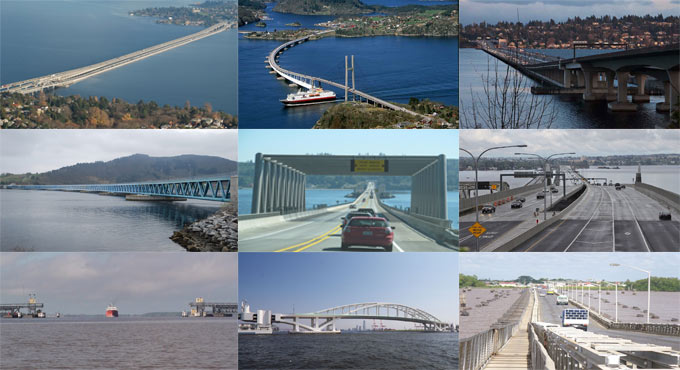
The top ten lengthiest Floating Bridges in the World and their construction details
Lacey V. Murrow Memorial Bridge, Seattle, U.S.A was developed in 1940. The bridge is 2,020 meters long. The bridge bears the eastbound lanes of Interstate 90 across Lake Washington from Seattle to Mercer Island, Wash. This floating bridge is constructed with concrete pontoons.
Hood Canal Bridge, U.S.A was developed in 1961. The length of the bridge is 1988 meters. The bridge bears State Route 104 across Hood Canal, a natural fjord that vacates into Puget Sound. The bridge attaches the Olympic and Kitsap Peninsulas. The water depth at the site varies from 24 to 104 m, containing various hundred feet of mud underneath, for the construction of support columns for conventional bridges become too expensive.
Demerara Harbour Bridge, Guyana, was developed in 1978. The length of the bridge is 1815 meters. The bridge extents the mouth of the Demerara River at Guyana?s capital, Georgetown.
The two- lane bridge presently conveys an average of 14,000 vehicles each day. Homer M. Hadley Memorial Bridge, U.S.A. was built up in 1989. The length of the bridge is 1,772 meters. It conveys the westbound and reversible lanes of Interstate 90 across Lake Washington among Mercer Island, Wash., and Seattle.
Berbice Bridge, Guyana was developed in 2008. The length of the bridge is 1571 meters. The bridge extents the mouth of the Berbice River and shows 39 pontoons.
Nordhordland Bridge, Norway, was developed on 1994. The length of the bridge is 1,246 meters (pontoon section). This combined cable- stayed and pontoon bridge adjacent to the city of Bergen attaches the mainland and the island of flat, spanning Salhusfjorden, that has 500m depth. It conveys two lanes for cars and a pedestrian / bicycle path. The floating section belongs to a steel box girder on top of 10 concrete pontoons, each contains nine watertight cells.
Bergsoysund Bridge, Norway was developed in 1992 and the length of the bridge is 933 meters. The bridge attaches the islands of Aspoya and Bergsoya, covering a fjord with a water depth of 320 meters.
The engineering firm Johns Holt made the design of the pontoons and abutments, and DNV Veritec made the design of the steel superstructure. Norwegian Contractors developed the concrete pontoons, and Akeer Verdal developed the steel pipe truss superstructure . It is supported with seven concrete pontoon foundations.
William R. Bennett Bridge, British Columbia, Canada was developed in 2008. The length of the bridge is 690 meters. The five- lane bridge is on nine pontoons with width 25m and the length varies from 25 m to 90 m.
Yumemeai Bridge, Osaka, Japan is 410 meters long. This floating swing bridge attaches two artificial islands, Yumeshima and Maishima, in Osaka Bay. A floating bridge design was chosen due to the soft ground of the reclaimed land. The bridge?s double arches are supported with two large steel pontoons. The pontoons were designed to avoid corrosion by binding their sides with titanium plates as well as a cathodic protection system.
The floating section of Evergreen Point Floating Bridge is 2,350 meters. The six- lane bridge conveys State Route 520 over Lake Washington from Seattle to its eastern suburbs. It involves 77 concrete pontoons which are attached to the lake bottom with 58 anchors tethered to steel cables.
Twenty- one of the pontoons that provide support to the deck and superstructure are each 110 m x 23 m x 8.5 m and weigh 10,000 tonnes. Fifty- four supplemental pontoons were applied to settle the weight of the bridge weigh 2,300 tonnes each. Two cross pontoons having weight 9,200 tonnes each at each end attach the deck to the fixed bridge approaches with hinges.
To get more details, go through the following video tutorial. youtube.com


